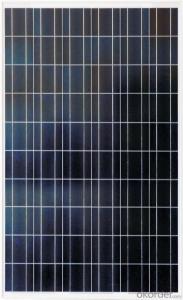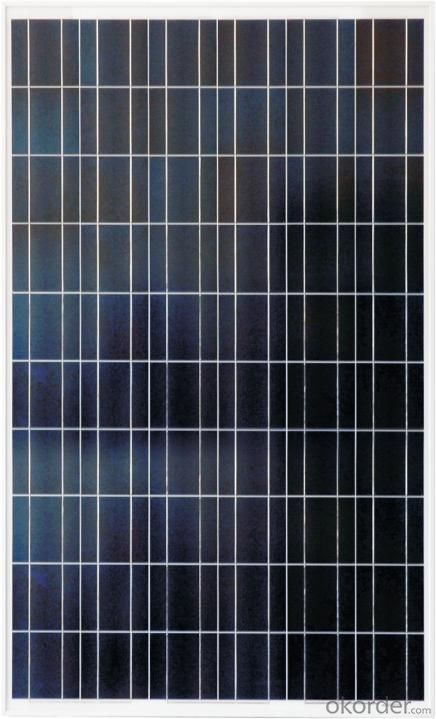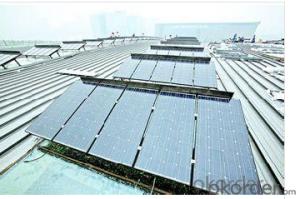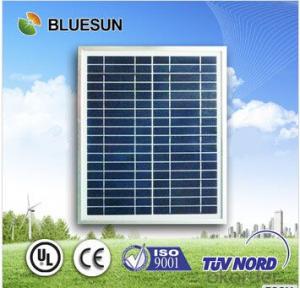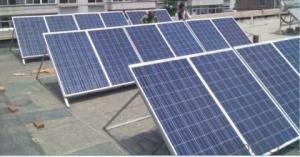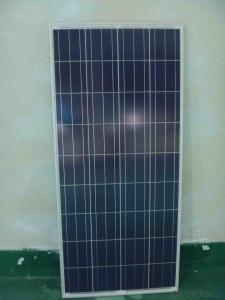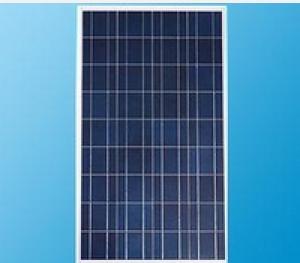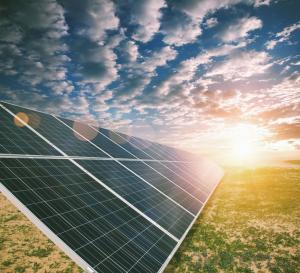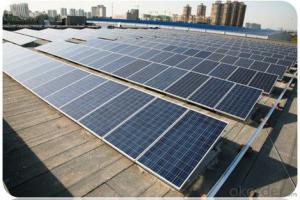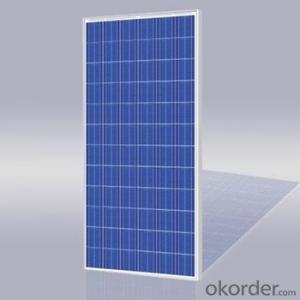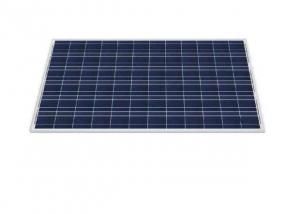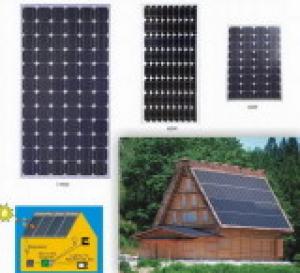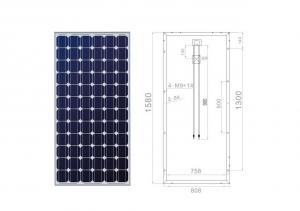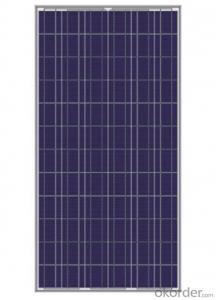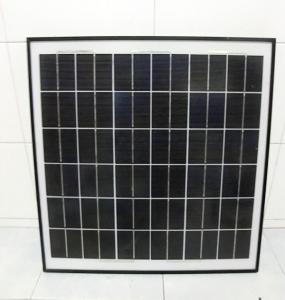Isp Solar Panels Polycrystalline Solar Module 245w
- Loading Port:
- China Main Port
- Payment Terms:
- TT OR LC
- Min Order Qty:
- -
- Supply Capability:
- -
OKorder Service Pledge
OKorder Financial Service
You Might Also Like
Solar Monocrystalline (210W-225W)
Introduction of Solar Monocrystalline (210W-225W)
Solar modules use light energy (photons) from the sun to generate electricity through the photovoltaic effect. The majority of modules use wafer-based crystalline silicon cells or thin-film cells based on cadmium telluride or silicon. The structural (load carrying) member of a module can either be the top layer or the back layer. Cells must also be protected from mechanical damage and moisture. Most solar modules are rigid, but semi-flexible ones are available, based on thin-film cells. These early solar modules were first used in space in 1958.
CNBM Solar photovoltaic (PV) Panel is designed for large electrical power requirements. It is the optimal choice for both on-grid and off-grid power systems. CNBM Solar panel offers high performance of power per square foot of solar array. Monocrystalline silicon(c-Si): often made using the Czochralski process. Single-crystal wafer cells tend to be expensive, and because they are cut from cylindrical ingots, do not completely cover a square solar cell module without a substantial waste of refined silicon. Hence most c-Si panels have uncovered gaps at the four corners of the cells.
Characteristics of Solar Monocrystalline (210W-225W)
I. Solar Cell : High efficiency crystalline solar cell. Even if under the weak light, the solar module can produce maximum power output.
II. Tempered glass (toughened glass): Anti-reflecting coating and high transmission rate glass increase the power output and mechanical strength of solar module.
III. EVA and TPT: Using high quality EVA and TPT to prevent destroying and water.
IV. AI frame: Without screw, corner connection. 6 holes on the frame can be installed easily.
V. Junction box: Multi function junction box with water proof.
VI. Long lifetime: ≥25 years; Less power decrease.
VII. Good performance of preventing from atrocious weather such as wind and hails.
VIII. Resisting moisture and etching effectively, not effected by geology.
IX. The certificate issued by international authority: UL, TUV, IEC, VDE, CE.
Standard Test Conditions of Solar Monocrystalline (210W-225W)
The opto-electrical specifications shown below are stabilized values being measured at Standard Test Conditions, Irradiance: 1000W/m2, Spectrum: AM1.5 at 25°C, The info below is subject to manufacturing tolerances. Where appropriate minutes of measurement are available and are used for the dimensioning of the installation.
Advantages of Solar Monocrystalline (210W-225W)
• CNBM Solar performance guarantees for 25 years
• 10 years guarantee for workmanship
• Timeliness of delivery
• Quality Products certified (TÜV, UL, CE, VDE, ISO)
CNBM International Corporation's products including Monocrystalline Solar Panel, Polycrystalline Solar Panel have received and enjoyed famous reputation in many countries and regions in the world .As a solar panel manufacturer in China, we strive to provide our customers with excellent service, superior products and unmatched value.
- Q: Why might energy from the solar panels sometimes be near zero even in the summer?
- Hey Cosmic, forget about Wayfare and Jenny here, but I have to say your question is a bit vague. When you say the panels produce near zero, how near? Are you using a watt meter, ammeter, or some other sort of metering device. Solar electric, or photovoltiac panels are made almost entirely of silicone wafers. Same as computer chips, when they get hot, the resist the flow of electrons. This is why most panel manufacturers advise installers to upgauge wiring if the temperature falls below 40 degrees F (5C) regularly. Below 0 C, you have to upgauge 2 wire sizes. A good quality panel will put out 50% of its rated power in very cold climates, so it stands to reason that they will put out substantially less in hot weather. Many people think places like the SW United States is great for solar because it's always sunny. In Las Vegas for example, they have 27 sunny days a month, and in August, the temperature frequently reaches 50 degrees C (20F) so people with photovoltiac panels are not even getting half their rated power on a good day. I'm not sure this is what you are asking about. Our home has been powered by the wind and sun for 2 years now. In the summer in the upper midwest, the days are warmer of course, but also much longer than in the winter. So our batteries will frequently fill up by 2:00pm, and the charge controller will taper off the solar charging the rest of the day to minimize overcharging. If you were to check the meters at 3pm, you might notice only 3 or 4 amps coming in when the array is rated at 42. This is normal for us in July and August. These are some reason why a solar array produces near zero in the summertime. Take care Cosmic, Rudydoo
- Q: What is the main material for making solar panels?
- If you make your own, in addition to buying silicon also need to buy for the packaging of silicon photovoltaic glass and EVA film.
- Q: What materials are solar panels made of?
- Solar panels are typically made of silicon, which is a semiconductor material, along with other components such as metal frames, glass, and protective layers.
- Q: how fast does a 25watt solar panel generate power to a battery? trying to figure out a conversion factor here to get a rough estimate of how many i would need to power my house, please help?
- If your house already has utility power, then your best move is usually to stay connected to the utility even when you install solar. Then, there are no batteries involved. Also, you never need to worry about not having enough power on cloudy days or at night. During the day, the solar panels drive the electric meter backwards, building up a credit with the electric company. Then at night, the meter runs forward normally. What you end up with is a very small electric bill instead of no bill, but the net cost is a lot less than using batteries. As to how large a system or how much it will cost, you would call a professional to size your system and give a quote. You can always say no if the numbers don't work out.
- Q: How do solar panels affect the property's energy efficiency rating?
- Solar panels have a positive impact on a property's energy efficiency rating by generating clean, renewable energy. By harnessing sunlight and converting it into electricity, solar panels reduce the reliance on traditional energy sources, leading to lower energy consumption and costs. This increased energy efficiency contributes to a higher rating for the property.
- Q: Hi, I bought 50 6X6 inch solar cells, I also bought a 40 amp diode, I still need to buy a battery, and inverter and a voltage controller, could you tell answer me the following questions:) I would like t build a small panel at first, (may be 0 X 0 inch), with that I would like (or at least to try) to power my laptop for the hole day, so I wont receive a very high amperage, yet, all the inverters I saw at e-bay are rated over 400 amp, if I buy a 400 amp inverter, can I use it with such a small amperage?2) what about buying a small car inverter, will it work?3) suggestion about the battery and the voltage controller will be kindly appreciated.Thanks
- I'm guessing that each of those solar cells is just 0.5 volt at max power, so if you make a 2-inch square panel, you will get 2 volts - not enough for the inverter. A car inverter is notoriously inefficient, but it would work if you connect it to a 2-volt battery. You cannot generally connect such an inverter to solar panels alone. The battery supplies the peak current that the inverter needs, and the panel charges the battery. To charge a 2-volt battery, you will want 36 cells, generally, which give you an 8-volt panel. You can buy an inexpensive charge controller somewhere. If your laptop will run off 2 volts directly, you can skip the inverter and be much more efficient. Or if the laptop runs of (say) 9 volts, you can use about 40 cells to get 20 volts, get the proper power plug from Radio Shack, and plug the panel directly into the laptop.
- Q: My Grandfather just purchased a cheap solar panel kit for his ranch that could not muster enough power to run his mini fridge.He has two 6 volt batteries running positive to negative and would like to add more batteries. Probably 2volt. How would he go about hooking up the other batteries and what kind of wire or coil should he use.Also, I saw on youtube a guy recommending a lead-acid battery from walmart for under $20. I was just going to go to ecology and just pick up some used batteries but I may be wrong.Any help for a first timer might help me and my gramps out will be appreciated.Thank you
- Solar charger employs solar energy to supply electricity to devices or charge batteries. They are generally portable. Solar array: electrical device consisting of a large array of connected solar cells Solar Panel is a group of solar cells arranged into a panel that can be installed onto a flat surface. The panel captures sunlight and converts it into DC power.
- Q: Can solar panels be installed on historical buildings?
- Yes, solar panels can be installed on historical buildings. However, the installation process may require careful planning and consideration to ensure that the historical integrity and architectural significance of the building are not compromised.
- Q: Can solar panels be used in areas prone to hurricanes?
- Yes, solar panels can be used in areas prone to hurricanes. However, it is important to ensure that the panels are properly installed and designed to withstand high wind speeds. Reinforcements, such as additional framing or anchoring systems, can be used to make the panels more resilient to hurricane conditions. Additionally, regular maintenance and inspections are necessary to ensure their stability and functionality.
Send your message to us
Isp Solar Panels Polycrystalline Solar Module 245w
- Loading Port:
- China Main Port
- Payment Terms:
- TT OR LC
- Min Order Qty:
- -
- Supply Capability:
- -
OKorder Service Pledge
OKorder Financial Service
Similar products
Hot products
Hot Searches
Related keywords
